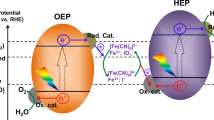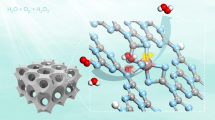Abstract
Sunlight-driven photocatalytic overall water splitting (OWS) presents a promising route towards solar-to-chemical energy conversion. However, OWS has been realized with only a few photocatalysts. Among the major reasons for this paucity are the reverse reactions that occur between OWS products, including hydrogen, oxygen and reactive intermediate species, on the photocatalyst surface. In this study we found that decorating the Rh co-catalyst of the benchmark photocatalyst GaN–ZnO with Al2O3 species by atomic layer deposition can suppress these reverse reactions to a great extent and consequently enhance the photocatalytic OWS activity by more than an order of magnitude, with an apparent quantum efficiency increase from 0.3% to 7.1% at 420 nm. The partial coverage of Rh surface sites with inert oxides can effectively suppress the reverse reactions by blocking the reduction/oxidation cycle of Rh atoms during the photocatalytic OWS reaction.

This is a preview of subscription content, access via your institution
Access options
Access Nature and 54 other Nature Portfolio journals
Get Nature+, our best-value online-access subscription
$29.99 / 30 days
cancel any time
Subscribe to this journal
Receive 12 digital issues and online access to articles
$119.00 per year
only $9.92 per issue
Buy this article
- Purchase on Springer Link
- Instant access to full article PDF
Prices may be subject to local taxes which are calculated during checkout




Similar content being viewed by others
Data availability
The data supporting the findings of this study are provided with the paper and are also available at https://www.scidb.cn/en/s/z67Jba or from the corresponding author upon reasonable request. Source data are provided with this paper.
References
Kudo, A. & Miseki, Y. Heterogeneous photocatalyst materials for water splitting. Chem. Soc. Rev. 38, 253–278 (2009).
Tachibana, Y., Vayssieres, L. & Durrant, J. R. Artificial photosynthesis for solar water-splitting. Nat. Photon. 6, 511–518 (2012).
Lewis, N. S. Research opportunities to advance solar energy utilization. Science 351, aad1920 (2016).
Hisatomi, T. & Domen, K. Reaction systems for solar hydrogen production via water splitting with particulate semiconductor photocatalysts. Nat. Catal. 2, 387–399 (2019).
Yang, J. H., Wang, D. G., Han, H. X. & Li, C. Roles of cocatalysts in photocatalysis and photoelectrocatalysis. Acc. Chem. Res. 46, 1900–1909 (2013).
Ran, J. R., Zhang, J., Yu, J. G., Jaroniec, M. & Qiao, S. Z. Earth-abundant cocatalysts for semiconductor-based photocatalytic water splitting. Chem. Soc. Rev. 43, 7787–7812 (2014).
Chen, S. S., Takata, T. & Domen, K. Particulate photocatalysts for overall water splitting. Nat. Rev. Mater. 2, 17050 (2017).
Iwase, A., Kato, H. & Kudo, A. Nanosized Au particles as an efficient cocatalyst for photocatalytic overall water splitting. Catal. Lett. 108, 7–10 (2006).
Maeda, K. et al. Noble-metal/Cr2O3 core/shell nanoparticles as a cocatalyst for photocatalytic overall water splitting. Angew. Chem. Int. Ed. 45, 7806–7809 (2006).
Tanaka, A., Teramura, K., Hosokawa, S., Kominami, H. & Tanaka, T. Visible light-induced water splitting in an aqueous suspension of a plasmonic Au/TiO2 photocatalyst with metal co-catalysts. Chem. Sci. 8, 2574–2580 (2017).
Wang, M., Li, Z., Wu, Y. Q., Ma, J. T. & Lu, G. X. Inhibition of hydrogen and oxygen reverse recombination reaction over Pt/TiO2 by F– ions and its impact on the photocatalytic hydrogen formation. J. Catal. 353, 162–170 (2017).
Lin, L. H. et al. Molecular-level insights on the reactive facet of carbon nitride single crystals photocatalysing overall water splitting. Nat. Catal. 3, 649–655 (2020).
Bau, J. A. & Takanabe, K. Ultrathin microporous SiO2 membranes photodeposited on hydrogen evolving catalysts enabling overall water splitting. ACS Catal. 7, 7931–7940 (2017).
Wang, Z. et al. Overall water splitting by Ta3N5 nanorod single crystals grown on the edges of KTaO3 particles. Nat. Catal. 1, 756–763 (2018).
Wang, Q. et al. Oxysulfide photocatalyst for visible-light-driven overall water splitting. Nat. Mater. 18, 827–834 (2019).
Kibria, M. G. et al. Visible light-driven efficient overall water splitting using p-type metal-nitride nanowire arrays. Nat. Commun. 6, 6797 (2015).
Chowdhury, F. A., Trudeau, M. L., Guo, H. & Mi, Z. T. A photochemical diode artificial photosynthesis system for unassisted high efficiency overall pure water splitting. Nat. Commun. 9, 1707 (2018).
Takata, T. et al. Photocatalytic water splitting with a quantum efficiency of almost unity. Nature 581, 411–414 (2020).
Yoshida, M. et al. Role and function of noble-metal/Cr-layer core/shell structure cocatalysts for photocatalytic overall water splitting studied by model electrodes. J. Phys. Chem. C. 113, 10151–10157 (2009).
Busser, G. W. et al. Cocatalyst designing: a regenerable molybdenum-containing ternary cocatalyst system for efficient photocatalytic water splitting. ACS Catal. 5, 5530–5539 (2015).
Soldat, J., Busser, G. W., Muhler, M. & Wark, M. Cr2O3 nanoparticles on Ba5Ta4O15 as a noble-metal-free oxygen evolution co-catalyst for photocatalytic overall water splitting. ChemCatChem 8, 153–156 (2016).
Phivilay, S. P. et al. Anatomy of a visible light activated photocatalyst for water splitting. ACS Catal. 8, 6650–6658 (2018).
Yoshida, M., Maeda, K., Lu, D., Kubota, J. & Domen, K. Lanthanoid oxide layers on rhodium-loaded (Ga1–xZnx)(N1–xOx) photocatalyst as a modifier for overall water splitting under visible-light irradiation. J. Phys. Chem. C. 117, 14000c14006 (2013).
Takata, T., Pan, C., Nakabayashi, M., Shibata, N. & Domen, K. Fabrication of a core–shell-type photocatalyst via photodeposition of group IV and V transition metal oxyhydroxides: an effective surface modification method for overall water splitting. J. Am. Chem. Soc. 137, 9627–9634 (2015).
Garcia-Esparza, A. T. et al. An oxygen-insensitive hydrogen evolution catalyst coated by a molybdenum-based layer for overall water splitting. Angew. Chem. Int. Ed. 56, 5780–5784 (2017).
Kanazawa, T., Nozawa, S., Lu, D. L. & Maeda, K. Structure and photocatalytic activity of PdCrOx cocatalyst on SrTiO3 for overall water splitting. Catalysts 9, 59 (2019).
Li, Y. H. et al. Unidirectional suppression of hydrogen oxidation on oxidized platinum clusters. Nat. Commun. 4, 2500 (2013).
Qureshi, M. et al. Catalytic consequences of ultrafine Pt clusters supported on SrTiO3 for photocatalytic overall water splitting. J. Catal. 376, 180–190 (2019).
Maeda, K. et al. Photocatalyst releasing hydrogen from water. Nature 440, 295 (2006).
Berto, T. F. et al. Enabling overall water splitting on photocatalysts by CO-covered noble metal co-catalysts. J. Phys. Chem. Lett. 7, 4358–4362 (2016).
Maeda, K. et al. GaN:ZnO solid solution as a photocatalyst for visible-light-driven overall water splitting. J. Am. Chem. Soc. 127, 8286–8287 (2005).
Hisatomi, T., Maeda, K., Takanabe, K., Kubota, J. & Domen, K. Aspects of the water splitting mechanism on (Ga1–xZnx)(N1–xOx) photocatalyst modified with Rh2–yCryO3 cocatalyst. J. Phys. Chem. C. 113, 21458–21466 (2009).
Wang, Q. et al. Scalable water splitting on particulate photocatalyst sheets with a solar-to-hydrogen energy conversion efficiency exceeding 1%. Nat. Mater. 15, 611–615 (2016).
Wang, Q. et al. Particulate photocatalyst sheets based on carbon conductor layer for efficient Z-scheme pure-water splitting at ambient pressure. J. Am. Chem. Soc. 139, 1675–1683 (2017).
Ikeda, T. et al. Polyol synthesis of size-controlled Rh nanoparticles and their application to photocatalytic overall water splitting under visible light. J. Phys. Chem. C. 117, 2467–2473 (2013).
Rice, C. A., Worley, S. D., Curtis, C. W., Guin, J. A. & Tarrer, A. R. The oxidation-state of dispersed Rh on Al2O3. J. Chem. Phys. 74, 6487–6497 (1981).
Lu, J. et al. First-principles predictions and in situ experimental validation of alumina atomic layer deposition on metal surfaces. Chem. Mater. 26, 6752–6761 (2014).
Cai, J. et al. Selective passivation of Pt nanoparticles with enhanced sintering resistance and activity toward CO oxidation via atomic layer deposition. ACS Appl. Nano Mater. 1, 522–530 (2018).
Zhang, H. et al. Atomic layer deposition overcoating: tuning catalyst selectivity for biomass conversion. Angew. Chem. Int. Ed. 53, 12132–12136 (2014).
Wang, H. et al. Disentangling the size-dependent geometric and electronic effects of palladium nanocatalysts beyond selectivity. Sci. Adv. 5, eaat6413 (2019).
McEwen, J. S., Gaspard, P., de Bocarme, T. V. & Kruse, N. Oscillations and bistability in the catalytic formation of water on rhodium in high electric fields. J. Phys. Chem. C. 113, 17045–17058 (2009).
Suchorski, Y. et al. Resolving multifrequential oscillations and nanoscale interfacet communication in single-particle catalysis. Science 372, 1314–1318 (2021).
Kresse, G. & Furthmuller, J. Efficiency of ab-initio total energy calculations for metals and semiconductors using a plane-wave basis set. Comput. Mater. Sci. 6, 15–50 (1996).
Kresse, G. & Furthmüller, J. Efficient iterative schemes for ab initio total-energy calculations using a plane-wave basis set. Phys. Rev. B 54, 11169–11186 (1996).
Blochl, P. E. Projector augmented-wave method. Phys. Rev. B 50, 17953–17979 (1994).
Perdew, J. P. et al. Atoms, molecules, solids, and surfaces—applications of the generalized gradient approximation for exchange and correlation. Phys. Rev. B 46, 6671–6687 (1992).
Hammer, B., Hansen, L. B. & Nørskov, J. K. Improved adsorption energetics within density-functional theory using revised Perdew–Burke–Ernzerhof functionals. Phys. Rev. B 59, 7413–7421 (1999).
Acknowledgements
This work was conducted by the Fundamental Research Center of Artificial Photosynthesis (FReCAP), financially supported by the National Natural Science Foundation of China (22088102). The work was also supported by the National Key Research and Development Program of China (2021YFA1502300) and the National Natural Science Foundation of China (22090033). We thank F. Zhang and J. Han for help in the preparation of GaN–ZnO, B. Zeng for helpful discussions and H. Han for revision of the English.
Author information
Authors and Affiliations
Contributions
C.L. conceived and supervised the research project. Z.L. and R.L. designed the experiments. Z.L. fabricated the photocatalysts and carried out the photocatalytic and electrochemical tests, XRD, UV–Vis DRS and TEM characterizations. H.J. and J.X. conducted the DFT calculations. H.X. and J.Z. helped with the ALD experiments. F.H. helped with the DRIFTS of CO adsorption. N.T. conducted the STEM and EDS measurements. X.Z. contributed to the conceptual discussion. C.L., Z.L. and R.L. analysed the results and wrote and revised the paper with input from the other authors.
Corresponding author
Ethics declarations
Competing interests
The authors declare no competing interests.
Peer review
Peer review information
Nature Catalysis thanks Hicham Idriss and the other, anonymous, reviewer(s) for their contribution to the peer review of this work.
Additional information
Publisher’s note Springer Nature remains neutral with regard to jurisdictional claims in published maps and institutional affiliations.
Supplementary information
Supplementary Information
Supplementary Methods, Notes 1 and 2, Figs. 1–15, Table and references.
Supplementary Data 1
Atomic coordinates of the optimized computational model structures.
Source data
Source Data Fig. 1
OWS activity.
Source Data Fig. 2
OWS activity and electrochemical current intensity.
Source Data Fig. 4
CO DRIFTS and theoretical simulations.
Rights and permissions
Springer Nature or its licensor (e.g. a society or other partner) holds exclusive rights to this article under a publishing agreement with the author(s) or other rightsholder(s); author self-archiving of the accepted manuscript version of this article is solely governed by the terms of such publishing agreement and applicable law.
About this article
Cite this article
Li, Z., Li, R., Jing, H. et al. Blocking the reverse reactions of overall water splitting on a Rh/GaN–ZnO photocatalyst modified with Al2O3. Nat Catal 6, 80–88 (2023). https://doi.org/10.1038/s41929-022-00907-y
Received:
Accepted:
Published:
Issue Date:
DOI: https://doi.org/10.1038/s41929-022-00907-y
This article is cited by
-
Large electronegativity differences between adjacent atomic sites activate and stabilize ZnIn2S4 for efficient photocatalytic overall water splitting
Nature Communications (2024)
-
Electrolyte-assisted polarization leading to enhanced charge separation and solar-to-hydrogen conversion efficiency of seawater splitting
Nature Catalysis (2024)
-
Enhancing visible-light-driven NO oxidation through molecular‐level insights of dye-loaded sea sands
Rare Metals (2024)
-
Gradient tungsten-doped Bi3TiNbO9 ferroelectric photocatalysts with additional built-in electric field for efficient overall water splitting
Nature Communications (2023)
-
Recent advances on aerobic photocatalytic methane conversion under mild conditions
Nano Research (2023)



